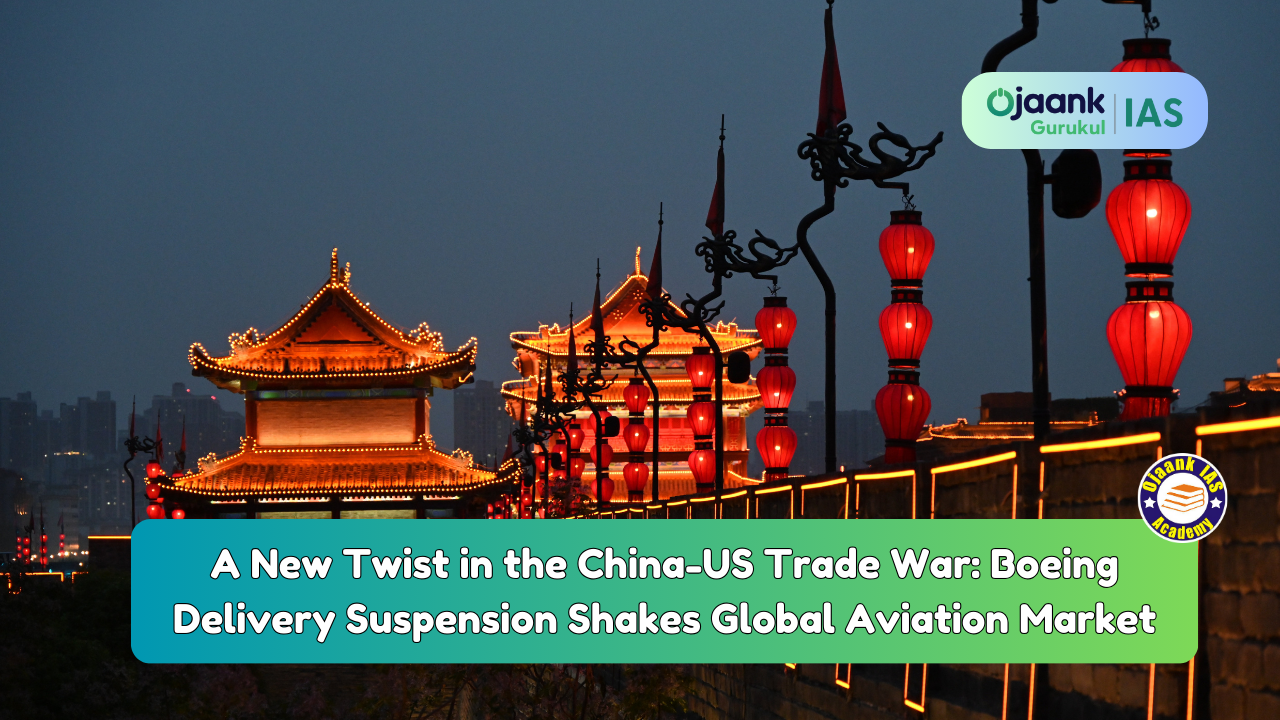A New Twist in the China-US Trade War: Boeing Delivery Suspension Shakes Global Aviation Market

 When Planes Become Weapons of War: Boeing Delivery Suspension Sends Global Shockwaves!
When Planes Become Weapons of War: Boeing Delivery Suspension Sends Global Shockwaves!
Welcome to the new frontline of global power politics—aviation.
China has fired a major shot by suspending deliveries of all Boeing aircraft, dealing a blow potentially worth $40 billion to the American aerospace giant. And trust us—this isn’t about trade alone. This is airborne economic warfare.
 Why Did China Take This Step?
Why Did China Take This Step?
This isn’t just business—it’s retaliation.
-
The Trump administration imposed tariffs up to 145% on Chinese imports, targeting electronics, steel, EVs, and tech.
-
The US is reshoring manufacturing, pushing for economic decoupling from China.
-
China responded by weaponizing aviation—targeting Boeing, a national industrial icon and a key pillar of US exports.
 How Much Will Boeing Lose?
How Much Will Boeing Lose?
Let’s crunch some cold numbers:
-
15% of Boeing’s global commercial aircraft sales go to China.
-
Between 2025–2027, over 150+ aircraft were scheduled for delivery to:
-
Air China – 45+
-
China Eastern – 35+
-
China Southern – 50+
-
Hainan Airlines – 10+
-
Boeing’s Current Troubles Just Got Worse:
-
737 MAX delays
-
787 Dreamliner quality issues
-
Ongoing FAA safety probes
-
Labor unrest and inflationary costs
-
A sharp 6% stock dip post-announcement
This is more than turbulence—it’s a crisis.
 Airbus: The Silent Winner
Airbus: The Silent Winner
While Boeing bleeds, Airbus thrives.
-
Airbus already operates assembly lines in Tianjin, China.
-
With Boeing out, Airbus becomes China’s go-to.
-
Europe is wooing China, driven by frustration with US trade unpredictability.
![]() Smart Move: Airbus is not just selling planes—they're building trust.
Smart Move: Airbus is not just selling planes—they're building trust.
 China’s Masterplan: COMAC Rises
China’s Masterplan: COMAC Rises
Enter the COMAC C919—China’s own passenger jet.
-
Backed by the Chinese state
-
Still not as advanced, but improving
-
A long-term play to reduce foreign dependency
-
Domestic contracts are already pouring in
China isn't just reacting—they're strategically investing in self-reliance.
 The Geopolitical Ripple Effects
The Geopolitical Ripple Effects
This isn’t just about planes:
China has also restricted exports of rare earths, magnets, lithium, and semiconductors—vital for:
Drones
Electric Vehicles
Missiles
Smartphones
Renewable energy infrastructure
Trade wars are no longer tariffs alone—they’re supply chain wars.
 Will This Hurt the US Trade Deficit?
Will This Hurt the US Trade Deficit?
Ironically, yes.
-
Aircraft sales are a key part of US exports to China.
-
Each cancelled Boeing deal worsens the deficit.
-
This hurts Trump’s core claim of "fixing the imbalance."
A full suspension could derail America’s export-led recovery in aviation.
 India's Unexpected Jackpot?
India's Unexpected Jackpot?
While US-China butt heads, India quietly climbs the runway.
The Numbers Tell the Story:
-
China: 4128+ active aircraft across 67 airlines
-
India: ~740 aircraft across 22 airlines
-
Air India & IndiGo: Recently ordered 500+ aircraft
Now that China is stepping back, India becomes the next premium customer.
Early delivery slots?
Global attention?
Faster aviation expansion?
This is India’s aerospace moment. Let’s not miss it.
 What’s Next for the US?
What’s Next for the US?
-
Boeing will lobby hard to remove or reduce tariffs.
-
Trade diplomats may be deployed to calm tensions.
-
The company may now pivot toward India, Latin America, and Middle East.
China might be lost. But the global south is still open.
 Conclusion: Not Just a Suspension—A Power Shift
Conclusion: Not Just a Suspension—A Power Shift
This Boeing delivery freeze is the clearest sign yet that the US-China rivalry has reached a new level.
It’s not just about exports or economics. It’s about control of strategic industries, influence in emerging markets, and the ability to shape the future of global transport and defense.
India now stands at a critical crossroads—either become a passive observer or step into the global cockpit.
 FAQs: Go Deeper, Think Smarter
FAQs: Go Deeper, Think Smarter
Q1: Can Boeing survive without China?
Yes, but only by aggressively tapping into India, UAE, Brazil, and Southeast Asia.
Q2: Will India benefit in the short term?
Yes—especially in faster aircraft delivery and better price leverage.
Q3: What does this mean for Airbus?
Airbus is poised to take major market share in China.
Q4: Can COMAC replace Boeing?
Not yet, but over the next 10–15 years, with enough support—it might.
 Final Thoughts: The Skies Are Political Now
Final Thoughts: The Skies Are Political Now
This isn’t just about metal and engines—it’s about hegemony.
And in this game of global chess, every aircraft is a move.
 Now It's Your Turn!
Now It's Your Turn!
![]() Do you think India should negotiate aggressively for Boeing/Airbus deals?
Do you think India should negotiate aggressively for Boeing/Airbus deals?
![]() Will COMAC ever become the third big name in aviation?
Will COMAC ever become the third big name in aviation?
![]() Share your thoughts in the comments.
Share your thoughts in the comments.
![]() Forward this to UPSC aspirants, geo-politics geeks, or aviation nerds.
Forward this to UPSC aspirants, geo-politics geeks, or aviation nerds.
![]() This is more than a blog—it’s a strategic blueprint.
This is more than a blog—it’s a strategic blueprint.